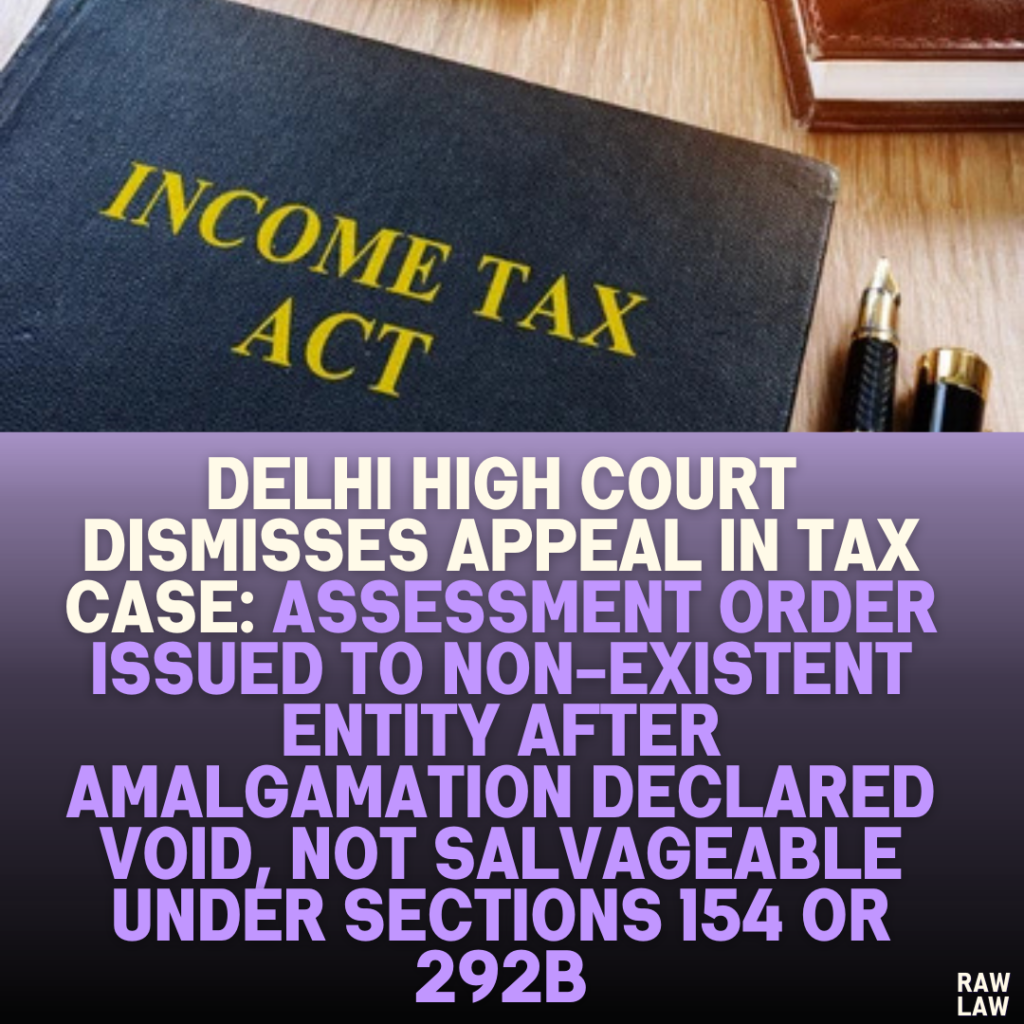Court’s Decision:
The High Court of Delhi dismissed the appeal filed by the Principal Commissioner of Income Tax. It held that an assessment order issued in the name of a non-existent entity due to amalgamation is fundamentally flawed and cannot be rectified under Section 154 or salvaged under Section 292B. The court relied heavily on the Supreme Court’s decision in Principal Commissioner of Income Tax v. Maruti Suzuki India Limited, which established that such jurisdictional errors render the entire proceeding a nullity.
Facts:
- Amalgamation and Entity Transition:
- M/s Cairn India Ltd. ceased to exist after its amalgamation with Vedanta Ltd., effective April 1, 2017.
- The appointed date of the merger was April 1, 2016, under the approved Scheme of Amalgamation.
- TPO’s Actions:
- The Transfer Pricing Officer (TPO) issued an order under Section 92CA(3) on October 29, 2018, in the name of M/s Cairn India Ltd., despite being informed of the merger.
- Draft Assessment Order:
- The Assessing Officer (AO) issued a draft assessment order on December 28, 2018, mentioning “M/s Vedanta Ltd. (formerly known as Cairn India Ltd.).” However, this did not reflect the legal reality of the merger, which created a new entity rather than a mere change in name.
- Rectification Attempt:
- The TPO attempted to rectify the error by issuing a correction under Section 154, citing it as a typographical mistake.
- Tribunal and Appeal:
- The Tribunal ruled against the Revenue, leading to the present appeal before the High Court.
Issues:
- Can an assessment order issued in the name of a non-existent entity be rectified under Section 154 of the Income Tax Act?
- Can such an order be validated under Section 292B, which protects proceedings from invalidation due to technical errors?
Petitioner’s Arguments (Revenue):
- Clerical Error:
The Revenue contended that the mistake in naming the entity was merely technical and could be rectified under Section 292B, citing Sky Light Hospitality LLP v. ACIT as precedent. - Intent:
The Revenue argued that the intent to assess Vedanta Ltd. was evident, making the error a curable mistake.
Respondent’s Arguments (Vedanta Ltd.):
- Jurisdictional Error:
The respondent argued that issuing an order in the name of a non-existent entity constituted a fundamental jurisdictional flaw, as held in Maruti Suzuki. Such an error invalidates the entire proceeding and cannot be rectified. - Failure to Acknowledge Merger:
The respondent emphasized that the authorities were informed of the merger but failed to consider its legal implications.
Analysis of the Law:
- Section 154:
- This provision allows for rectification of mistakes apparent from the record, such as typographical errors or omissions.
- The court held that issuing an order against a non-existent entity is not a minor mistake but a jurisdictional error and thus outside the scope of Section 154.
- Section 292B:
- This provision saves proceedings from invalidation due to procedural errors, provided the proceedings are otherwise in compliance with the law.
- The court ruled that framing an order in the name of a dissolved entity is a substantive error, not a procedural one, and therefore cannot be saved by Section 292B.
Precedent Analysis:
- Maruti Suzuki:
- The Supreme Court held that proceedings against a non-existent entity due to amalgamation are invalid and cannot be rectified or validated under Section 292B.
- This case established that the jurisdictional basis of such proceedings is fundamentally flawed.
- Sky Light Hospitality:
- The court distinguished this case, noting that the peculiar facts in Sky Light—including substantial evidence of intent to address the successor entity—allowed the Supreme Court to validate the proceedings.
- However, the present case lacked such evidence, making Sky Light inapplicable.
Court’s Reasoning:
- Acknowledgement of Merger:
- The authorities were informed of the merger but failed to assess the successor entity, instead issuing an order in the name of a non-existent company.
- Misunderstanding the Legal Effect of Amalgamation:
- The AO treated the amalgamation as a mere name change, reflected in the use of the phrase “formerly known as,” rather than recognizing the creation of a new legal entity.
- Irreparable Flaw:
- The court emphasized that issuing an order in the name of a dissolved entity is a substantive illegality, not a procedural lapse. Such errors cannot be cured under Section 154 or 292B.
Conclusion:
The court dismissed the appeal, reaffirming that proceedings initiated against a non-existent entity are null and void. It ruled that such jurisdictional errors cannot be rectified or saved under Sections 154 and 292B.
Implications:
- Legal Clarity:
The judgment reinforces the principle that jurisdictional compliance is critical in tax proceedings. - Obligation on Tax Authorities:
Tax authorities must exercise due diligence in identifying the correct legal entity, especially in cases involving mergers or amalgamations. - Consistency in Tax Litigation:
The decision underscores the importance of consistency, as established by Maruti Suzuki, to ensure predictability in legal outcomes.



